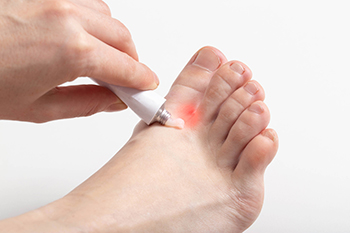
Athlete's foot is a fungal condition, scientifically termed tinea pedis, that predominantly targets the feet's skin. It earns its moniker from its frequency among athletes, who are prone to damp footwear conditions, yet it is an ailment that can affect anyone. The responsible pathogens, known as dermatophytes, flourish in the dampness of shoes, shared showers, and sports gear. Those with the infection often endure a rash that not only scales but also itches, burns, and stings, with the skin between the toes being particularly susceptible to peeling and cracking. The condition is communicable and spreadable through both direct skin contact and through shared surfaces like floors or towels. To initially treat athlete's foot, antifungal treatments are typically prescribed. Preventive measures include maintaining dry feet and impeccable hygiene. Without appropriate treatment, the infection can invite more severe bacterial complications, a significant risk for people with compromised immune systems. If you suspect you have athlete’s foot, it is suggested that you make an appointment with a chiropodist for a proper diagnosis and treatment options.
Athlete’s foot can be uncomfortable and unsightly. To learn more about preventing and treating this condition, please consult with Chiropodist Stephanie Poupore from North Bay Foot & Ankle. Our clinician will assess your condition and provide you with quality foot and ankle treatment.
What Is Athlete’s Foot?
Athlete’s foot refers to an infection of the skin on the feet that is caused by a fungus. This fungus is contagious and thrives in warm and moist environments. It is often spread in common areas such as public pools, locker rooms, and showers. It can also spread when sharing personal items, like shoes or towels, with an infected person.
Symptoms
The symptoms of athlete’s foot may include:
Itching, stinging, or burning of the skin on the feet
Cracking or peeling skin, especially between the toes and on the soles of the feet
Scaly, red rash on the foot
Blisters
Foul odor
Treatment
Treatment for athlete’s foot typically involves using over-the-counter topical antifungal medications on the feet. When over-the-counter options are ineffective, you may need to take prescription oral medications or topical antifungal drugs, or a combination of both.
Prevention
Preventing athlete’s foot places an emphasis on good foot hygiene practices.
You can prevent athlete’s foot by:
Washing and drying your feet thoroughly every day
Wearing shoes when walking in public areas
Not sharing personal items, like shoes or socks, with others
Wearing shoes and socks made out of breathable materials
If you have any questions, please feel free to contact our office located in . We offer the newest diagnostic and treatment technologies for all your foot care needs.
